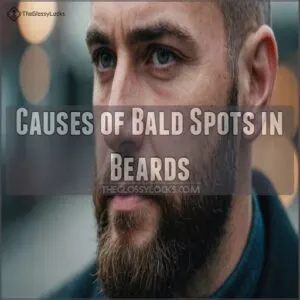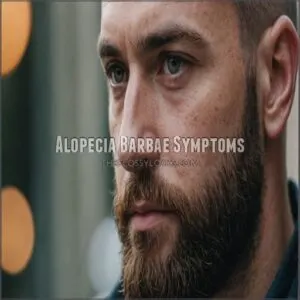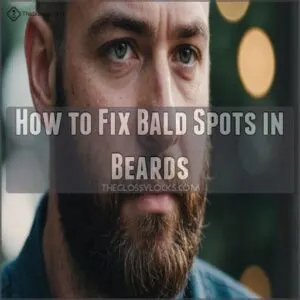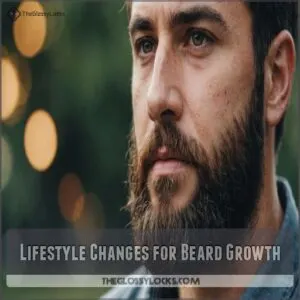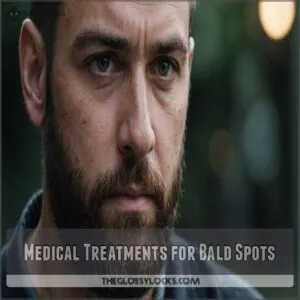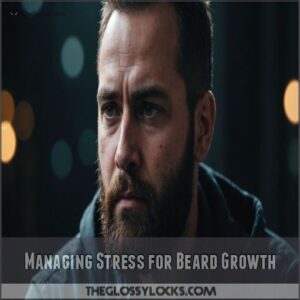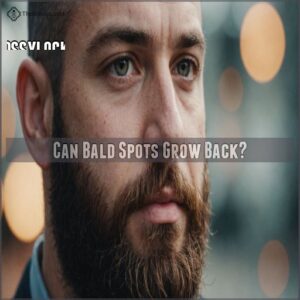This site is supported by our readers. We may earn a commission, at no cost to you, if you purchase through links.
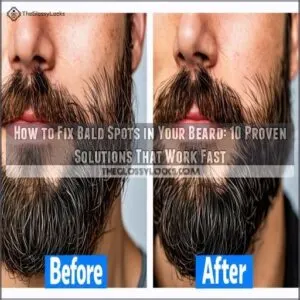 Fixing bald spots in your beard can feel like trying to solve a tricky puzzle, but it’s doable!
Fixing bald spots in your beard can feel like trying to solve a tricky puzzle, but it’s doable!
Start by eating a balanced diet rich in vitamins to boost hair growth.
Give your beard time—it might surprise you by filling in those gaps.
Manage stress and stay active; this helps improve blood flow and can encourage growth.
Some guys swear by minoxidil, a topical treatment.
And hey, don’t be afraid to experiment with different beard styles while waiting for growth.
A patchy beard, often caused by hormonal imbalances, genetics, or stress, can be transformed with the right techniques, as seen in popular patchy beard styles. Remember, a patchy beard today could be a lush forest of facial hair tomorrow if you play your cards right!
Table Of Contents
- Key Takeaways
- Causes of Bald Spots in Beards
- Symptoms of Bald Spots in Beards
- How to Fix Bald Spots in Beards
- Lifestyle Changes for Beard Growth
- Supplements for Beard Growth
- Medical Treatments for Bald Spots
- Natural Remedies for Beard Growth
- Managing Stress for Beard Growth
- Can Bald Spots Grow Back?
- Maintaining a Healthy Beard
- Frequently Asked Questions (FAQs)
- How to prevent beard bald spots?
- Is there a cure for balding?
- How do you treat a bald patch in a beard?
- What causes a bald spot in your beard?
- Can you regrow patchy beard?
- How do you fix a shaved bald spot?
- Can a bald spot grow back?
- Will a patchy beard eventually fill in?
- Can diet changes impact beard health?
- Do certain hairstyles help hide bald spots?
- How long to see results from remedies?
- Can beard oils prevent bald spots?
- Are certain ethnicities more prone to patchiness?
- Conclusion
Key Takeaways
- Eat a balanced diet rich in vitamins and nutrients, including supplements that support beard growth with beard growth vitamins like biotin, vitamin C, and zinc, to support beard growth and fill in bald spots.
- Incorporate regular exercise and stress management techniques to boost testosterone and improve circulation for better beard growth.
- Consider using minoxidil or microneedling to stimulate dormant hair follicles and speed up the process of filling in patchy areas.
- Maintain a healthy beard with proper grooming practices, using beard oil and conditioner to enhance hair health and manageability.
Causes of Bald Spots in Beards
If you’re noticing patches in your facial hair, you’re dealing with a common issue that can stem from your genes, hormone levels, or even your daily habits.
Your beard’s patchy spots might be frustrating, but understanding what’s causing them is your first step toward finding the right solution that’ll work for your unique situation.
Genetics and Hormonal Imbalance
Let’s face it: your beard’s patchy spots might be playing hide and seek thanks to your family tree.
Your genetics directly influence how your facial hair responds to hormones like testosterone and DHT (dihydrotestosterone).
If you’ve noticed your dad or brothers rocking patchy beards, you’re likely dealing with similar genes.
You can try using a beard growth shampoo to help stimulate growth, but keep in mind that it mightn’t be a magic bullet.
Low testosterone or insensitive androgen receptors can also throw a wrench in your beard growth goals.
Poor Circulation and Lifestyle Factors
Poor circulation hits your beard growth like a traffic jam on your face, starving those follicles of essential nutrients.
Your daily habits pack a punch too – burning the midnight oil, stress eating, and skipping workouts can throw your hormones into chaos.
Think of your beard as a garden: it needs proper blood flow, good nutrition, and enough rest to flourish.
Even your late-night Netflix binges might be sabotaging your facial forest.
Medical Conditions Affecting Beard Growth
When your beard starts playing hide and seek, medical conditions might be the sneaky culprits behind those mysterious bald patches.
Understanding these conditions can help you tackle beard loss head-on and find the right treatment path.
Your immune system or skin health could be throwing a wrench in your beard game.
- Alopecia areata acts like an overprotective bouncer, making your immune system attack hair follicles
- Ringworm isn’t actually a worm – it’s a fungal infection that can create circular bald spots
- Tinea barbae shows up as red, scaly patches that love to crash your beard party
- Some medications and treatments, like chemotherapy, can temporarily put your beard growth on pause
Symptoms of Bald Spots in Beards
You’ll notice those pesky beard patches when your facial hair grows in uneven clusters or completely stops growing in certain spots, often due to underlying conditions like alopecia areata causes, leaving you with a less-than-impressive beard situation.
If you’re seeing circular bald spots or experiencing unusual itching and redness, you might be dealing with a treatable condition that’s stopping your dream beard from reaching its full potential.
Patchy Beard Growth Patterns
Spotting those pesky gaps in your beard growth can feel like solving a puzzle.
You’ll notice uneven patches scattered across your face, with some areas growing thick and others staying stubbornly bare.
Your genetics might be playing hide and seek with your facial hair, creating a mosaic pattern that’s unique to you.
Don’t worry though – these patterns often fill in with time and proper care.
Alopecia Barbae Symptoms
Those mysterious bald spots in your beard might be a sign of an underlying condition such as an autoimmune disease like alopecia areata that’s causing hair loss. Those mysterious bald spots in your beard might be caused by an autoimmune disease that mistakenly attacks hair follicles, as seen in cases of alopecia barbae symptoms. Those mysterious bald spots in your beard might be alopecia barbae making an unwanted appearance. Beyond random patchiness, this autoimmune condition has some telltale signs you’ll want to watch for: If you’re not sure what’s causing your beard bald spots, understanding beard bald spots can help you identify the underlying issue. Completely smooth, round patches where beard hair used to be No redness, scaling, or irritation in the bald areas * Hair loss that happens pretty quickly, sometimes overnight
Don’t panic though – a dermatologist can help you tackle this head-on!
Ringworm and Other Infections
Your beard’s mysterious patches might’ve an uninvited guest: ringworm.
Unlike alopecia’s clean patches, fungal infections leave red, scaly rings that can make your beard feel like it’s on fire.
You’ll notice intense itching, flaking, and small bald spots with broken hairs.
Don’t panic – these infections are treatable with antifungal medications.
Just remember, the longer you wait, the harder it’ll be to kick these unwanted visitors out.
How to Fix Bald Spots in Beards
Tired of those pesky beard bald spots?
You’re about to discover some proven solutions that’ll have you rocking a full, luscious beard in no time.
From letting your facial hair grow out to trying minoxidil, we’ve got the tips you need to fill in those patches and boost your beard game.
Allow Your Beard to Grow
Identifying the cause of your patchy beard, such as alopecia areata or fungal infections like Tinea barbae causes, is crucial for effective treatment. Patience is the secret sauce for fixing patchy beards.
Let your facial fuzz flourish for at least two months to see its true potential.
During this growth journey, you’ll experience:
- Excitement as stubble transforms into a rugged look
- Frustration when facing the dreaded "awkward stage"
- Curiosity about your unique growth pattern
- Pride as your beard fills in those pesky bald spots
Remember, every beard’s a snowflake – unique and beautiful in its own time.
Embrace the journey, and you’ll be rocking that full beard before you know it!
Dietary Changes for Beard Growth
Often, what you eat can make or break your beard game.
Pack your plate with beard growth foods like sorghum, oysters, and olive oil.
These powerhouses are packed with nutrients that boost hair health.
Don’t forget to sip on pomegranate juice and coffee – they’re secret weapons for a thicker mane.
And hey, why not sprinkle some alfalfa sprouts on your salad?
Your beard will thank you!
Using Minoxidil for Beard Growth
While eating right can boost your beard, sometimes you need an extra push.
Enter minoxidil, the beard growth superhero.
This over-the-counter wonder can work wonders for those patchy spots.
Here’s what you need to know:
- Apply twice daily for best results
- Be patient – it can take 3-6 months to see changes
- Watch out for potential side effects like dry skin
Remember, minoxidil isn’t magic.
It works best when combined with a healthy lifestyle and proper beard care.
Microneedling for Beard Growth
Pricking your way to a fuller beard? Microneedling might be your ticket. This technique uses tiny needles to stimulate dormant follicles, potentially boosting beard growth. You’ll need a derma roller and some guts, but the results can be worth it.
| Derma Roller Size | Frequency | Best For |
|---|---|---|
| 0.25mm | 2-3x/week | Beginners, sensitive skin |
| 0.5mm | 1-2x/week | Most users, general use |
| 0.75-1.0mm | Every 2 weeks | Advanced, stubborn patches |
Remember, start slow and be consistent. Your beard will thank you!
Lifestyle Changes for Beard Growth
You don’t need to spend a fortune on fancy beard products to fix those pesky bald spots.
By making a few simple lifestyle changes, you’ll boost your testosterone and give your beard the TLC it needs to grow thick and full.
Exercise and Testosterone Boost
Ready to bulk up your beard? Hit the gym!
Regular weightlifting can pump up your testosterone levels, giving your facial hair a growth boost.
Aim for intense workouts 3-4 times a week, focusing on compound exercises like squats and deadlifts.
Don’t forget to fuel your gains with protein-rich foods.
Remember, consistency is key – stick to your routine, and you’ll soon be sporting a fuller, manlier mane.
Sleep and Stress Management
Ever feel like your beard’s battling stress? You’re onto something.
Quality sleep and stress management are your secret weapons for a fuller beard. Aim for 7-9 hours of shut-eye nightly to boost testosterone production.
Tackle stress head-on with meditation or yoga to keep cortisol in check. Remember, a relaxed mind means a thriving beard. So, take a deep breath and watch those patches fill in!
Intimacy and Testosterone Levels
While you’re catching those Z’s, don’t forget about another bedroom activity that can boost your beard game.
Getting intimate isn’t just fun; it’s a natural testosterone booster.
Here’s how it helps:
- Increases blood flow to your face
- Boosts hormone production
- Reduces stress, which can hinder growth
So, cuddle up with your partner and let nature work its magic on your facial hair.
Who knew growing a beard could be so enjoyable?
Supplements for Beard Growth
You’ve tried all the creams and oils, but your beard still looks like a patchy mess?
It’s time to give supplements a shot – they might just be the secret weapon your facial hair needs to fill in those frustrating bald spots.
Multivitamins and Amino Acids
Your beard’s growth isn’t just about lifestyle – it’s also about what’s on your plate.
A quality multivitamin can fill nutritional gaps, giving your facial hair the boost it needs.
Consider visiting online stores that offer beard growth supplements to find the right fit for you.
Amino acids are the building blocks of protein, essential for robust hair growth.
But don’t fall for "beard growth" pills – stick to proven supplements.
Remember, what’s good for your body is good for your beard!
L-Carnitine L-tartrate and Mucuna Pruriens
Looking to boost your beard game?
L-Carnitine L-tartrate might be your secret weapon.
This amino acid enhances androgen receptor sensitivity, potentially turbocharging your beard growth.
Pair it with Mucuna Pruriens, a natural testosterone booster, for a one-two punch.
Start with 2-3 grams of L-Carnitine daily and 300-500mg of Mucuna.
Remember, results vary, so be patient and consistent.
Always check with your doc before starting any new supplement regimen.
Avoiding Unproven Supplements
Don’t get suckered by those flashy "beard pills" promising a forest on your face overnight.
They’re often just expensive placebos.
Stick to science-backed options like multivitamins and L-Carnitine L-tartrate.
Remember, there’s no magic potion for instant beard growth.
Focus on overall health and proven supplements.
If something sounds too good to be true, it probably is.
Save your hard-earned cash for a quality beard oil instead.
Medical Treatments for Bald Spots
If your beard’s looking more like a patchy quilt than a majestic mane, don’t worry – medical treatments can help.
From tackling pesky conditions like alopecia barbae to zapping fungal foes, these solutions might just be the ticket to filling in those frustrating bald spots.
Treating Alopecia Barbae
Tackling alopecia barbae head-on can feel like climbing a mountain, but don’t worry – you’ve got options.
This autoimmune condition might be stubborn, but so are you.
Consider that minoxidil can increase blood flow to hair follicles, prolonging the active growth phase, which is a key aspect of the hair growth treatment for alopecia.
Here’s your game plan:
- Try topical corticosteroids to reduce inflammation
- Consider immunotherapy to retrain your immune system
- Look into JAK inhibitors for severe cases
Remember, you’re not alone in this journey.
Join support groups and stay updated on research – your beard’s comeback story is just beginning!
Ringworm and Fungal Infections
While alopecia barbae can be tricky, fungal infections like ringworm can also crash your beard party.
These sneaky invaders cause circular bald spots that itch like crazy.
Don’t scratch that itch!
Instead, keep your beard squeaky clean and see a doc for antifungal meds.
They’ll knock out those fungi faster than you can say "beard goals."
Remember, prevention’s your best friend – practice good beard hygiene to keep the fungus at bay.
Chemotherapy-Induced Hair Loss
Chemotherapy can be tough on your hair, including your beard.
You might experience hair loss, which can be caused by hormonal shifts or nutritional deficiencies, common causes of hair loss, during treatment, but don’t lose hope.
Many guys find support groups helpful for coping with the emotional impact.
While waiting for regrowth, consider temporary hair loss solutions like gentle beard oils or fake beards for special occasions.
Remember, your beard will likely return after treatment ends.
Stay positive and rock whatever look makes you feel confident!
Natural Remedies for Beard Growth
You don’t need to raid a pharmacy to fix your patchy beard; Mother Nature’s got your back.
From peppermint oil to beard-boosting foods like pomegranate juice, you’ll find plenty of natural ways to coax those stubborn hairs out of hiding.
Peppermint Essential Oil
Imagine stepping out of a medical treatment, hoping for that lush beard. Now, add peppermint essential oil to your mix and watch the magic happen. It’s like nature’s cologne that boosts beard growth, and combining it with the right beard growth oils can lead to even more impressive results. Here’s how:
- Peppermint oil benefits your follicles.
- Create DIY beard balm with it.
- Explore peppermint oil vs. minoxidil.
Beard Growth-Promoting Foods
Peppermint oil’s wonders have their limits, so let’s look at your meal plan for help.
While a balanced diet rich in beard growth vitamins like Vitamin D, Zinc, and Biotin is essential for a healthy beard Learn More About Beard Vitamins. Eating top beard foods can spur growth from within.
Load up on sorghum, known for its DHT-boosting effect.
Add oysters for zinc, helping sporting a fuller beard.
Remember, a balanced diet is like sunshine to a garden, nurturing robust, thriving beard growth.
Olive Oil and Pomegranate Juice
Give olive oil a whirl—it’s known for its moisturizing magic that can help your beard grow thicker, and while some may think shaving helps, beard thickness facts reveal that genetics and hormones are the main factors determining beard thickness.
Mixing in pomegranate juice adds a punch of antioxidants, boosting blood flow and supporting new growth.
You’re basically giving your beard a spa day at home.
Incorporate these natural beard remedies into your diet for beard growth, and watch the transformation!
Managing Stress for Beard Growth
Managing stress is very important for beard growth because high stress can increase cortisol levels, which inhibits hair growth.
By incorporating stress relief techniques like exercise, you’ll improve your mood but also give your beard a fighting chance to fill in those stubborn bald spots.
Reducing Cortisol Levels
Thinking about stress’s grip on your beard?
Lowering cortisol could be your ticket to fuller growth.
This sneaky hormone ups its game during stressful moments, messing with your beard’s journey.
Quality sleep and mindful practices—like a relaxing bedtime routine—can tip the scales in your favor.
Letting stress take a back seat might just rev up your beard’s engine.
Stress Management Techniques
Lowering cortisol isn’t just about diet; it’s about mindset.
Try meditation or deep breathing exercises – they’re surprisingly effective!
Yoga and mindfulness can help too.
Even aromatherapy, with calming scents, can make a difference.
Remember, less stress equals better beard growth!
Find what works for you; it’s all about self-care.
Exercise and Stress Relief
Imagine ditching stress for good, like getting rid of that last stubborn pimple.
To bolster beard growth, try:
- Workouts: Release testosterone, reduce cortisol—hello, thicker beard!
- Sleep: Prioritize it; growth hormones peak during slumber.
- Stress Management: Meditate, run, or zen out—stress smothers your beard dreams.
Embrace these tips and watch your beard thrive!
Can Bald Spots Grow Back?
Wondering if your beard’s bald spots will make a comeback?
Good news—they often can with some patience and the right strategies, so let’s explore how to nurture those stubborn patches back to life.
Regrowing Patchy Beards
Curious if your patchy beard can grow back?
Trust me, you’ve got options!
First, let your beard chill for a bit—patience is key.
Nurture it with beard oil for a nourishing touch.
Keep stress at bay to help your follicles thrive.
Here’s a quick guide:
| Beard Booster | Benefit |
|---|---|
| Beard Oil | Softens hair |
| Reduced Stress | Boosts growth |
| Healthy Diet | Strengthens beard |
| Good Sleep | Aids growth |
Filling in Bald Spots
You’ve waited patiently for those patchy beard spots to fill in, but it feels like watching paint dry.
Research suggests that understanding the cause of patchy beard growth, such as hormonal imbalances and genetics, can help you find the right solution.
The good news is, with the right touch—think minoxidil effectiveness and hair follicle stimulation—you’re not stuck with those gaps forever.
Beard oil benefits add that little extra oomph, promoting a thicker appearance while providing an aromatic bonus.
Preventing Further Hair Loss
Hair loss triggers are like sneaky thieves, so keep them at bay by managing stress and improving nutrition for growth.
Boost scalp health with gentle massages and make sure hormone balance by getting enough sleep.
Imagine this: a little effort now means fewer bald patches later!
Remember, a balanced lifestyle isn’t just good advice—it’s your beard’s best friend.
Maintaining a Healthy Beard
Keeping your beard healthy is as easy as using the right products and being gentle during grooming.
Think of it like taking care of a pet—show it some love with oils and careful trimming, and you’ll prevent those pesky bald spots.
Using Beard Oil and Conditioner
Want a beard that’s both glorious and healthy?
Think of beard oil and conditioner as your secret weapons.
They’re not just for show; they’re essential for growth.
Here’s why you should use them:
- Beard oil benefits your skin and softens your beard.
- Conditioners add shine and manageability.
- Application is easy – just a few drops after showering!
Trimming and Grooming
Imagine your beard as a masterpiece in progress.
Just as beard oil softens and nourishes, trimming and grooming shape your look.
To maintain a healthy short beard, be mindful of genetics, lifestyle, and diet which impact growth speed and thickness.
Keep your beard fresh with regular care.
Here’s a quick guide:
| Step | Technique | Tip |
|---|---|---|
| 1. Trim | Use a sharp trimmer | Follow your jawline |
| 2. Groom | Apply quality products | Opt for natural ingredients |
| 3. Style | Experiment with angles | Balance with face shape |
Consistency is key!
Avoiding Damage and Breakage
After trimming it just right, keeping your beard healthy is key.
Avoid the pitfalls of careless grooming with these tips:
- Skip heat styling for your beard; it’s not a blow-dry bar.
- Use beard oil to keep it sleek and soft.
- Opt for gentle combing techniques.
- Pat dry with a soft towel; rough ones are a no-go.
- Keep those fingers out of it.
Frequently Asked Questions (FAQs)
How to prevent beard bald spots?
Prevent beard bald spots by maintaining a balanced diet, rich in beard-boosting foods like oysters and olive oil.
Regular exercise and adequate sleep can improve hormone levels.
Consider using minoxidil or a derma roller to stimulate growth.
Is there a cure for balding?
Over 80 million Americans struggle with balding.
While there’s no absolute cure, treatments like minoxidil, finasteride, and hair transplants offer hope.
Embrace hair loss like a badge of honor, or explore these options to boost confidence!
How do you treat a bald patch in a beard?
Got a patchy beard? Don’t sweat it! Try minoxidil, a derma roller, or peppermint oil. A healthy diet and lifestyle also help. You’ve got this!
What causes a bald spot in your beard?
Bald spots in your beard can spring from genetic quirks, low testosterone, stress, or nutrition gaps.
Sometimes, it’s just uncooperative skin or alopecia.
Give your beard love with balanced meals, stress-busting activities, and good care practices.
Can you regrow patchy beard?
Dreaming of a fuller beard?
You’re not alone!
Patience is key; let it grow for two months.
Try using minoxidil, a derma roller, and essential oils.
Boost with beard-friendly foods like oysters and olive oil.
How do you fix a shaved bald spot?
Wait a week or two for regrowth before panicking about that shaved bald spot!
Use a little hair growth serum and gently massage the area to stimulate follicles and boost circulation, helping your hair make a swift comeback.
Can a bald spot grow back?
Sure, bald spots can grow back, depending on the cause.
Factors like stress or poor nutrition are often fixable.
Trying things like eating nutritional foods, using essential oils, and reducing stress might give those follicles a revival.
Will a patchy beard eventually fill in?
Think of Sam, who ended up with a full, lush beard after waiting a few months.
Your patchy beard might fill in with time, good nutrition, and proper care.
Patience is key, just like watering plants.
Can diet changes impact beard health?
Absolutely, tweaking your diet can boost beard health.
Foods rich in vitamins and minerals, like oysters, olive oil, and coffee, support growth.
These delicious snacks might just be the missing piece in your beard game!
Do certain hairstyles help hide bald spots?
Clever styling can camouflage those pesky spots!
Try longer styles to blend patches.
A well-groomed beard, even a shorter one, can also minimize their appearance.
Experiment to find what works best for you!
How long to see results from remedies?
You’ll typically start seeing results from beard growth remedies like minoxidil or essential oils within 4 to 8 weeks.
Consistency is key, so stick with your routine and enjoy watching your beard transform over time!
Can beard oils prevent bald spots?
Worried beard oils won’t help bald spots?
They won’t fill gaps magically, but they do condition and promote healthier growth.
They’re like giving plants water—they nourish existing hairs but can’t grow new ones where none exist.
Are certain ethnicities more prone to patchiness?
Different ethnicities can have varied beard growth patterns due to genetics, as some ethnicities tend to have less facial hair than others, which can be influenced by factors such as family history and genetics. Different ethnicities can have varied beard growth patterns due to genetics.
Asians often have lower levels of dihydrotestosterone (DHT), which regulates facial hair growth, affecting their beard growth potential. Asians and Native Americans often experience patchier beards, whereas men from Middle Eastern and Mediterranean backgrounds typically grow fuller facial hair.
Each beard is uniquely yours!
Conclusion
Think of your beard like a garden—give it love, patience, and the right nutrients, and it’ll grow lush over time.
Eating well, reducing stress, and experimenting with different solutions like minoxidil or microneedling can help you fix bald spots in your beard.
While it mightn’t happen overnight, sticking with a healthy routine and grooming can foster growth.
Embrace the journey, and soon those patchy spots could transform into a dense, enviable beard!

